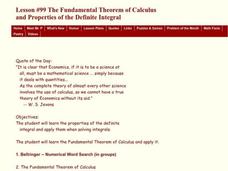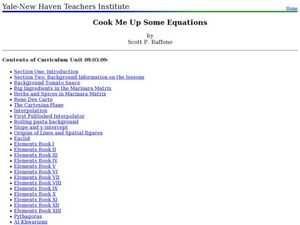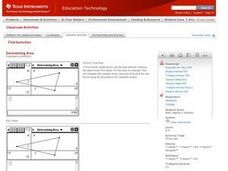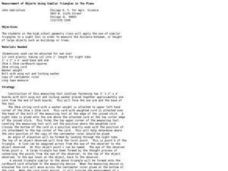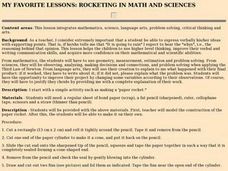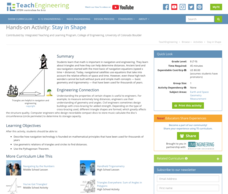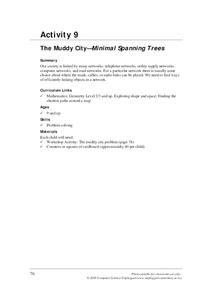Curated OER
The Fundamental Theorem of Calculus and Properties of the Definite Integral
Learners discuss the importance of fundamental theorems in math. In this calculus lesson, students define the fundamental theorem of calculus and discuss why it is so important they understand it. They work problems to model how this...
Curated OER
Lasting Legacies of Ancient Greece
Ancient Greece lesson plans can open up a world of information for students.
Curated OER
Cook Me Up Some Equations
Students study a variety of math concepts in the context of cooking up a meal. In this math activity, students calculate surface area and volume. They draw and interpret different types of graphs.
Curated OER
Determining Beam Stress and Deflection with COSMOSXpress
Students analyze cantilever stress using COSMOSXpress. In this engineering lesson, students calculate the beam's maximum deflection. They investigate the effect changing beam dimensions.
Curated OER
Determining Area
High schoolers conduct chemical experiments. In this chemistry lesson, they investigate reactions using the CBL system. Learners will graph and analyze their data using a TI.
Texas Instruments
Areas of Regular Polygons and Circles
Learners explore area of polygons and regular polygons in this math lesson. They calculate the area of several polygons using Cabri Jr. and analyze shapes and write formulas to solve for the area.
Curated OER
Classifying Triangles by the Length of the Sides Using Cabri Jr.
Learners follow detailed directions to create triangles on their graphing calculator. In this properties of triangles lesson, they will create triangles on their calculators using the Cabri Jr. application. They then identify three...
Curated OER
Everyday Objects with Shapes
Young scholars explore geometric shapes. In this geometry and language development instructional activity, students take a walk and look for shapes in the objects outdoors. Young scholars match each of four individual ...
Curated OER
Four Color Map
Students explore geometry by completing a color puzzle. For this shape identification lesson, students utilize deductive reasoning to complete a Google SketchUp puzzle with trapezoid, triangles and rectangular shapes. Students...
Curated OER
Shapes (Geometric)
Second graders explore geometric shapes. In this instructional activity about geometry, 2nd graders create their own vest using geometric shapes. Students work with a partner and fit their partner for the vest they design. Students...
Curated OER
Measurement of Objects Using Similar Triangles in The Plane
Young scholars use similar triangles and a sight tool to find the height and distance between large objects. In this similar triangles lesson plan, students use a constructed sight tool to measure the distance and height of an object...
Curated OER
From Where to Where?
Students find locations based upon their latitude and longitude coordinates. In this latitude and longitude instructional activity, students locate points on a grid and learn how to use an astrolabe.
Curated OER
Two-Dimensional Drawings from Three Dimensional Objects
Sixth graders identify and replicate two dimensional illustrations of three dimensional objects. In this spatial visualization lesson, 6th graders practice viewing objects from various sides. Student participate in stations to view...
Curated OER
It Counts
Students explore one to one number correspondence. In this early math lesson, students make observations about and classify plants in order to gain an understanding of using numbers to describe their world.
Curated OER
Slope Right Up
Students use triangles to find the length and slope of each side. After connecting the vertices, they add points based on their specific instructions. They use the Pythagorean Theorem to complete a worksheet to end the lesson.
Curated OER
If You Can’t Stand the Heat
Students design and build their own solar cooker. In this math lesson, students determine the relationship between the angles of the sun, reflection and cooking time of the solar cooker. They test their project, collect data and...
Curated OER
Social Studies: Renaissance
Students explore Renaissance architecture. In this Renaissance instructional activity, students view a slideshow featuring architecture of the era and then discuss the math skills used to the build the structures. Student build their own...
Curated OER
Legends of the Fifth
Students explore the the legends and myths of the Orient, Africa, Europe, Asia, and the Americas in this six lessons unit. Different cultures and belief systems of the inhabitants of these areas are examined through storytelling techniques.
Curated OER
Creating the Model
Students comprehend what has been explored in the previous earthquake engineering design lessons, by putting their designs to the test.
They are given pairs a piece of paper, and an empty plastic bottle or can. Students stand the...
Curated OER
It Counts
Students assign numbers to describe objects. In this number activity, students assign numbers to objects and compare more, less, and equal values. They write down descriptions of plants including the number of leaves and height of the...
Curated OER
Rocketing in Math and Sciences
Students make a rocket out of paper. They follow the given instructions and test to see if it will fly. They write about the experiment and are given the opportunity to change their varibles to make their rocket work.
Teach Engineering
Stay in Shape
Using their knowledge of right triangles, pupils find out how far a ship is from a light house. Class members determine how far around the world a ship would be sailing at a constant speed.
Education Development Center
Similar Triangles
Model geometric concepts through a hands-on approach. Learners apply similar triangle relationships to solve for an unknown side length. Before they find the solution, they describe the transformation to help identify corresponding sides.
Computer Science Unplugged
The Muddy City—Minimal Spanning Trees
What is the most efficient way to ensure everyone is connected? Individual pupils determine the least expensive route to pave roads in a fictional city. In doing so, they learn to find the minimal spanning tree for the situation. They...


